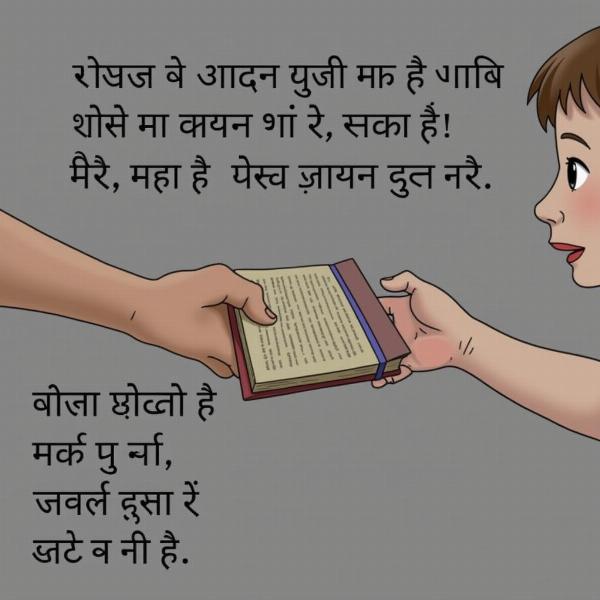Understanding the nuances of Hindi can be challenging, especially when trying to convey specific meanings. If you’re searching for how to say “give him” in Hindi, this guide offers a detailed explanation, encompassing various contexts and grammatical considerations. “Give him” in Hindi isn’t a simple one-to-one translation, and the correct phrasing depends heavily on the object being given and the formality of the situation.
Understanding the Verb “to Give” in Hindi
The primary Hindi verb for “to give” is देना (denā). However, its usage isn’t as straightforward as its English counterpart. The verb conjugates based on the gender, number, and person of the recipient, adding complexity to the translation of “give him.”
“Give Him” in Different Contexts
Let’s explore different ways to express “give him” in Hindi, considering the object being given and the social context:
-
Giving a physical object: If you’re giving him a book, you might say उसे किताब दो (use kitāb do) – literally, “to him book give.” Notice how the word order changes compared to English. If the object is feminine, like a pen (कलम – kalam), the verb changes to दीजिए (dījie) in a more formal or respectful context, becoming उसे कलम दीजिए (use kalam dījie).
-
Giving a non-physical object: Giving something abstract, like information or advice, requires a slightly different approach. You could use the verb बताना (batānā – to tell) or समझाना (samjhānā – to explain). For instance, “Give him the information” could translate to उसे जानकारी दो (use jānkārī do) or उसे जानकारी बताओ (use jānkārī batāo).
-
Formal vs. Informal: The level of formality also influences the verb conjugation. Using दीजिए (dījie) instead of दो (do) adds a layer of respect. Similarly, using the pronoun आप (āp – you, formal) instead of तुम (tum – you, informal) when addressing the person giving the object alters the overall politeness.
 Giving a Book in Hindi
Giving a Book in Hindi
Using Pronouns Correctly
Understanding Hindi pronouns is crucial for accurately conveying “give him.” उसे (use) is the most common pronoun for “him” in the objective case. However, other pronouns might be appropriate depending on the context, such as उसको (usko) which is slightly less formal.
Give Him This, Give Him That
Specific phrases like “give him this” and “give him that” also have tailored translations in Hindi. “Give him this” translates to इसे उसे दो (ise use do) or formally इसे उसे दीजिए (ise use dījie). Similarly, “give him that” becomes उसे वह दो (use vah do) or formally उसे वह दीजिए (use vah dījie).
Common Mistakes to Avoid
- Direct Translation: Avoid directly translating “give him” word for word. The Hindi sentence structure and verb conjugation differ significantly.
- Ignoring Gender and Number: Pay close attention to the gender and number of the object being given, as it affects the verb conjugation.
- Incorrect Pronoun Usage: Ensure you’re using the correct pronoun based on the context and level of formality.
Conclusion
Mastering the different ways to say “give him” in Hindi requires understanding the interplay of verbs, pronouns, and context. This guide provides a foundation for constructing grammatically correct and culturally appropriate sentences, enabling you to communicate effectively in Hindi. Remember to consider the object being given, the level of formality, and the appropriate pronoun to convey the precise meaning.
FAQ
-
What is the most common Hindi verb for “to give”? The most common verb is देना (denā).
-
How do I say “give him a book” in Hindi? You can say उसे किताब दो (use kitāb do).
-
What is the formal way to say “give him”? The formal way often involves using दीजिए (dījie) and the appropriate pronoun.
-
What is the difference between उसे (use) and उसको (usko)? While both mean “to him,” उसे (use) is generally preferred and considered more grammatically correct in most contexts. उसको (usko) is often used in spoken Hindi or more informal settings.
-
How do I make the sentence “give him this” polite in Hindi? Use the formal pronoun and verb: इसे उसे दीजिए (ise use dījie).
-
Why is it important to consider the gender of the object being given? The gender of the object influences the verb conjugation in Hindi.
-
Is it okay to directly translate “give him” into Hindi? No, direct translation often leads to grammatically incorrect and unnatural-sounding sentences.
Meaning-Hindi.in specializes in accurate and nuanced Hindi translations across various domains, from business and legal documents to technical manuals and educational materials. Our expert linguists ensure your message is conveyed with cultural sensitivity and linguistic precision. Need help with your Hindi translation projects? Contact us at [email protected] or call us at +91 11-4502-7584. Meaning-Hindi.in provides professional Hindi translation services to help you connect with your target audience effectively.